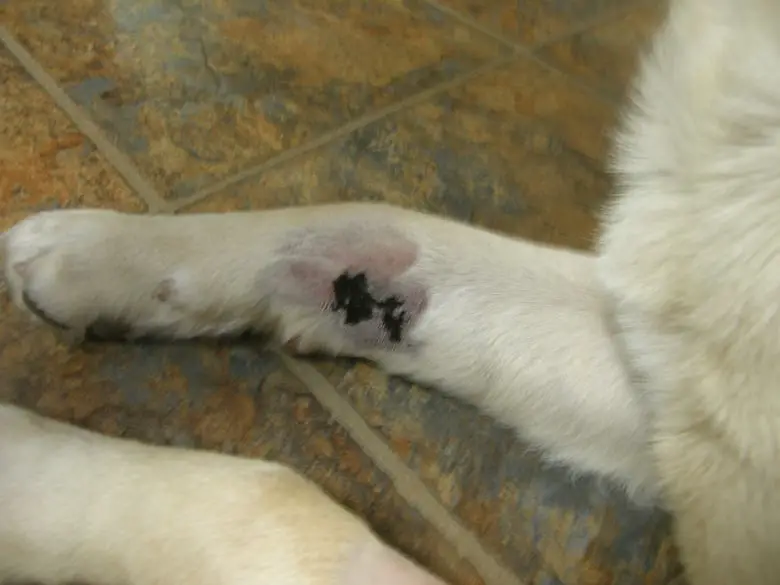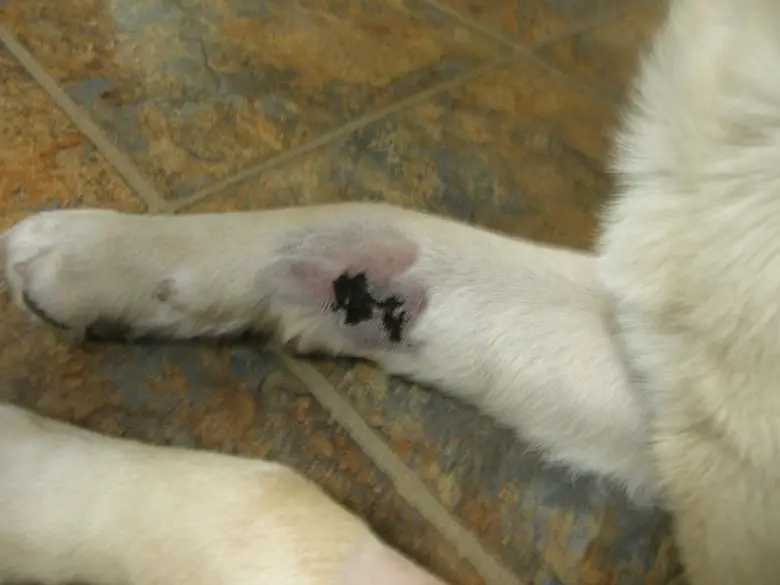As a pet owner, it’s natural to worry about the dangers that your furry friend may encounter. One of the most common threats is a rattlesnake bite. But just how can you tell if your dog has been bitten by one of these venomous reptiles?
The appearance of a rattlesnake bite on a dog can vary depending on several factors, including the size of the dog, the location of the bite, and the severity of the envenomation. In this article, we’ll discuss what a rattlesnake bite may look like on your dog and what steps you should take if you suspect your pet has been bitten.
A rattlesnake bite on a dog can be very dangerous. The bite can cause swelling, pain, and even death. The appearance of the bite depends on the size of the dog and the location of the bite. The bite may appear as two puncture wounds, and the area may become swollen and red. It’s important to seek immediate veterinary attention if you suspect your dog has been bitten by a rattlesnake.

**What Does a Rattlesnake Bite Look Like on a Dog?**
Rattlesnake bites are a serious concern for dog owners, particularly those who live in areas with a high snake population. These bites can be fatal if not treated quickly and properly. It’s crucial for dog owners to know what a rattlesnake bite looks like on a dog, so they can quickly recognize the symptoms and seek veterinary care.
**Symptoms of a Rattlesnake Bite on a Dog**
The symptoms of a rattlesnake bite on a dog can vary depending on the severity of the bite. In general, however, the following symptoms may be present:
**H3: Swelling and Pain**
The area around the bite will swell and become painful. The swelling may be mild or severe, depending on the amount of venom injected and the size of the dog. The pain may also be mild or severe. The dog may yelp or cry out when the bite occurs, and may be reluctant to put weight on the affected limb.
**H3: Redness and Bruising**
The area around the bite may also become red and bruised. This is due to the venom’s effect on the blood vessels in the area. The redness and bruising may be mild or severe, depending on the amount of venom injected.
In some cases, the bruising can be extensive and may spread to other areas of the body. This is a sign that the venom is affecting the dog’s blood clotting ability and can be a life-threatening situation.
**H3: Difficulty Breathing**
In severe cases, a rattlesnake bite can cause difficulty breathing. This is due to the venom’s effect on the respiratory system. The dog may pant heavily or struggle to breathe. This is a life-threatening situation and requires immediate veterinary care.
**H3: Vomiting and Diarrhea**
Some dogs may experience vomiting and diarrhea after being bitten by a rattlesnake. This is due to the venom’s effect on the digestive system. The dog may also become lethargic and lose its appetite.
**H3: Treatment for Rattlesnake Bites on Dogs**
If you suspect that your dog has been bitten by a rattlesnake, seek veterinary care immediately. Time is of the essence when it comes to treating these bites.
The veterinarian will assess the severity of the bite and administer antivenom if necessary. The dog may also receive pain medication and fluids to help with hydration.
It’s important to keep the dog calm and still during treatment, as movement can cause the venom to spread more quickly through the bloodstream.
**H3: Prevention of Rattlesnake Bites on Dogs**
Prevention is the best way to protect your dog from rattlesnake bites. Avoid walking your dog in areas with a high snake population, particularly during the warm months when snakes are most active.
Consider getting your dog vaccinated against rattlesnake venom. This vaccine can help reduce the severity of the bite if your dog is bitten.
Additionally, consider training your dog to avoid snakes. This can be done through positive reinforcement training and can help keep your dog safe in areas where snakes are present.
**H3: Conclusion**
Rattlesnake bites are a serious concern for dog owners, but with proper prevention and treatment, they can be managed. Know the symptoms of a rattlesnake bite on a dog and seek veterinary care immediately if you suspect your dog has been bitten.
By taking steps to prevent rattlesnake bites and training your dog to avoid snakes, you can help keep your furry friend safe from this potentially deadly threat.
Frequently Asked Questions
Here are some common questions about rattlesnake bites on dogs.
What are the symptoms of a rattlesnake bite on a dog?
When a dog is bitten by a rattlesnake, there are several symptoms that may appear. These can include swelling, pain, redness, and bleeding at the site of the bite. The dog may also experience difficulty breathing, vomiting, and diarrhea. In some cases, the dog may go into shock and experience seizures or collapse.
If you suspect your dog has been bitten by a rattlesnake, it is important to seek veterinary care immediately. Time is of the essence and early treatment can make a big difference in the dog’s recovery.
How is a rattlesnake bite on a dog treated?
The treatment for a rattlesnake bite on a dog typically involves antivenom, which is a medication that neutralizes the venom and helps to prevent further damage. The dog may also be given pain medication and fluids to help support its body. In some cases, the veterinarian may need to perform surgery to remove damaged tissue or to stabilize the dog’s condition.
After the initial treatment, the dog will likely need to be monitored closely for several days to ensure that it is recovering well. In some cases, additional treatments may be necessary if the dog experiences complications or long-term effects from the snake bite.
Can a dog die from a rattlesnake bite?
Yes, a dog can die from a rattlesnake bite if it does not receive prompt and appropriate treatment. The venom from a rattlesnake can cause severe damage to a dog’s tissues and organs, and can even lead to death if left untreated. However, with early treatment, many dogs are able to recover fully from a rattlesnake bite.
If you live in an area where rattlesnakes are common, it is important to keep your dog on a leash and to be aware of your surroundings when walking or hiking. This can help to prevent your dog from encountering a snake and being bitten.
What should I do if my dog is bitten by a rattlesnake?
If you suspect that your dog has been bitten by a rattlesnake, it is important to seek veterinary care immediately. Do not attempt to treat the bite yourself, as this can be dangerous and may not be effective in neutralizing the venom. Keep your dog as calm and still as possible during transport to the veterinarian, as this can help to slow the spread of the venom through the body.
If possible, try to identify the type of snake that bit your dog, as this can help the veterinarian to determine the appropriate treatment. However, do not put yourself in danger by trying to capture or kill the snake.
How can I prevent my dog from being bitten by a rattlesnake?
There are several steps you can take to help prevent your dog from being bitten by a rattlesnake. First, keep your dog on a leash when walking or hiking in areas where snakes are common. This can help to prevent your dog from wandering off and encountering a snake.
You can also consider getting your dog vaccinated against rattlesnake venom. This vaccine can help to reduce the severity of the dog’s reaction to a snake bite and can give you more time to seek veterinary care. However, it is important to note that the vaccine is not 100% effective and should not be relied upon as the sole method of prevention.
What Happens if a Rattlesnake BITES You?
In conclusion, it is important to be aware of the signs of a rattlesnake bite on your dog. While the appearance of the bite may vary depending on the severity of the bite and your dog’s reaction, it is typically characterized by swelling, redness, and tenderness around the bite area.
If you suspect that your dog has been bitten by a rattlesnake, seek immediate veterinary attention. Delaying treatment can result in serious complications, including tissue damage, infection, and even death.
Prevention is key when it comes to protecting your dog from rattlesnake bites. Consider vaccinating your dog against rattlesnake venom and keeping them on a leash when walking in areas where snakes may be present. By taking these precautions, you can help keep your furry companion safe and healthy.


